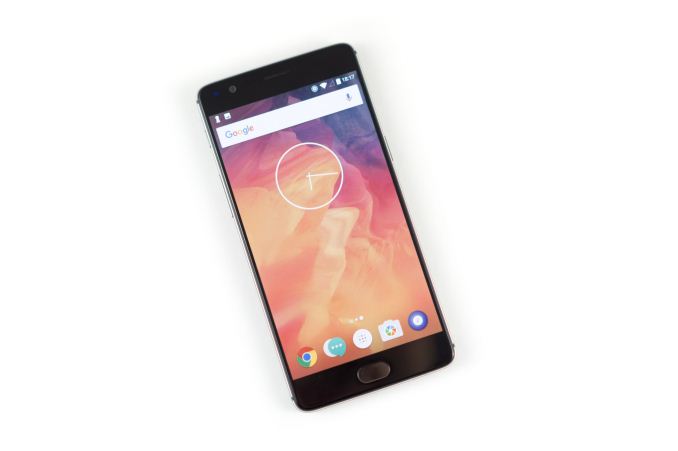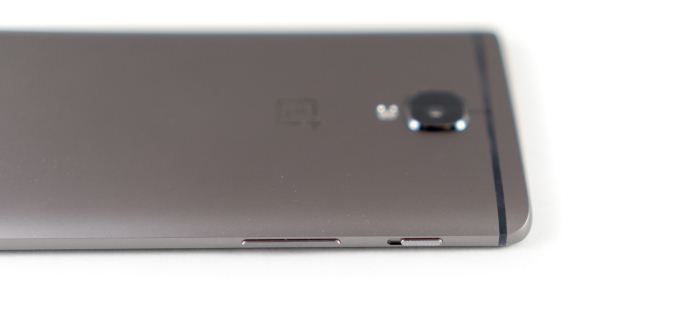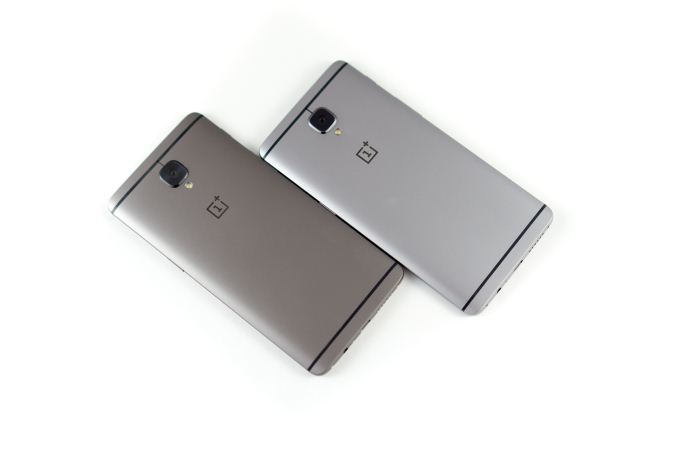The OnePlus 3T Review
by Brandon Chester on November 28, 2016 10:30 AM EST- Posted in
- Smartphones
- OnePlus
- OnePlus 3T

Back in June, OnePlus launched their new flagship smartphone, the OnePlus 3. I've had an interesting relationship with the OnePlus 3 due to certain decisions that were made regarding its display and some parts of the operating system before the phone initially launched. Since that time, OnePlus has made significant improvements to both of these aspects, and in my follow up piece I concluded that the OnePlus 3 should be considered by all smartphone buyers, even ones who were ready to pay $700 or $800 for a flagship phone from another company.
Earlier this month, OnePlus surprised a number of people in the Android community by launching a successor to the OnePlus 3. This move isn't in line with the yearly cadence that we've come to expect for their smartphones, which makes it all the more interesting. The name of this new phone is the OnePlus 3T, and based on that name one can already see that it represents an evolution of the OnePlus 3 rather than a revolutionary upgrade. As the OnePlus 3's successor, the OnePlus 3T simply serves to update certain aspects of the phone's hardware in order to take advantage of technology improvements that have been made available since the OnePlus 3 was originally developed and released.
This review focuses on the aspects of the OnePlus 3T that differ from its predecessor. Because of that, I recommend reading over my review of the OnePlus 3 if you're interested in other aspects of the phone like the camera quality. Before moving on, I've collected all the specifications for the OnePlus 3 and 3T in the chart below to make it clear which parts have changed and which have remained the same.
| OnePlus 3 | OnePlus 3T | ||
| SoC | Qualcomm Snapdragon 820 2 x 2.15GHz Kryo 2 x 1.6GHz Kryo 624MHz Adreno 530 |
Qualcomm Snapdragon 821 2 x 2.35GHz Kryo 2 x 1.6GHz Kryo 653MHz Adreno 530 |
|
| RAM | 6GB LPDDR4 | ||
| Display | 5.5" 1920 x 1080 PenTile AMOLED | ||
| Size / Mass | 152.7 x 74.7 x 7.35mm, 158g | ||
| Battery | 3000 mAh | 3400 mAh | |
| Rear Camera | 16MP 1.1 μm Sony IMX298, f/2.0, OIS | ||
| Front Camera | 8MP 1.4 μm Sony IMX179, f/2.0 |
16MP 1.0 µm Samsung S5K3P8, f/2.0 |
|
| Storage | 64GB UFS 2.0 | 64/128GB UFS 2.0 | |
| I/O | USB 2.0 Type-C connector, 3.5mm audio | ||
| Connectivity | 1x1 802.11a/b/g/n/ac + BT 4.2, USB-C, GPS/GNSS | ||
| Software | Android 6.0.1 OxygenOS 3.2.8 |
Android 6.0.1 OxygenOS 3.5.1 |
|
| Price | 64GB 399 USD |
64GB 439 USD 439 EUR 399 GBP 599 CAD |
128GB 479 USD 479 EUR 439 GBP 639 CAD |
For the most part, the OnePlus 3T is the same as the OnePlus 3. The size and mass are both the same, the display is the same, the rear-camera is the same, and the connectivity is the same. Internally OnePlus has made some changes to certain components. The most obvious change is the new SoC, with Snapdragon 820 being replaced with a faster Snapdragon 821 chip, while the RAM remains a healthy 6GB of LPDDR4. The battery capacity has also increased from 3000mAh to 3400mAh, which is a 13% increase without any change in the size or mass of the phone. The last major change is the new front-facing camera, which has moved from the 8MP 1.4µm Sony sensor on the OnePlus 3 to a 16MP 1.0µm Samsung sensor. In addition to the changes across all models, OnePlus has also introduced a 128GB SKU for users who need more storage. All of these changes also come at a higher price, with the 64GB model starting at $439, up from $399, and the 128GB model coming in at $479.
Design
As far as its design goes, the OnePlus 3T is mostly unchanged from its predecessor. I'm quite a fan of the OnePlus 3's design, so I don't feel that there was any need to change it significantly. The relatively thin body and the tapered back design make it far more usable with one hand than other 5.5" smartphones like the Pixel XL or the Moto G4. Being made from a single piece of aluminum, the chassis has none of the seams that the OnePlus One and OnePlus 2 had, and it feels incredibly solid in the hand. Unlike certain other vendors, OnePlus has also taken the time to actually align the various ports and buttons on the sides of the chassis instead of placing them wherever is convenient without any regard for aesthetics or usability.
Beyond the purely physical aspects of the design, I think OnePlus's design decisions regarding the placement of controls also makes the phone easier to use than competing devices. Having been using the OnePlus 3 since launch, I can say with certainty that OnePlus is on the right side of history by putting the volume rocker on the left side of the phone along with a physical switch for toggling notification settings. I also really appreciate having capacitive navigation buttons instead of wasting space on the display with on-screen buttons sitting above a bottom bezel that could easily fit physical ones. Putting the fingerprint scanner on the front of the phone as part of the home button also makes it simple to turn on and unlock the phone, even if it's sitting on a table.
The only aspect of the design that has changed from the OnePlus 3 is the color of the phone. The OnePlus 3 was originally available in a standard silver aluminum finish and later came in a gold finish, while the OnePlus 3T comes in a gunmetal grey finish and a gold finish from the start. The gold finish is only available in a 64GB capacity, while the gunmetal has both a 64GB and a 128GB version. For this review the 128GB gunmetal model was sampled, and I think it's a nice look for the phone. It's certainly not as dark as Apple's black iPhone 7 finish, but it's visibly darker than the OnePlus 3's aluminum and helps to distinguish between the two. I wouldn't have minded if OnePlus had also kept the standard silver finish available, as I think it looked rather nice as well, but I don't think the gunmetal is such a dramatic change in color that users will be bothered by silver being unavailable.












104 Comments
View All Comments
mortimerr - Monday, November 28, 2016 - link
Very few people, especially here, would voluntarily want to use whatever custom OS ZTE uses on the Axon 7, and even though ZTE is finally giving the appropriate data needed to get sound working with CM, it's still very early nightlies with numerous bugs you'd have to contend with.Where it's a completely different world with OP. And that's even if you decide not to use OxygenOS.
ToTTenTranz - Monday, November 28, 2016 - link
And the Axon 7 has a 1440p 5.5" AMOLED screen. And a dedicated DAC for reproducing 24/32bit audio sources, and amplified dual front-facing speakers.And it's allegedly one of the first few devices to support Daydream along with the Pixel phones.
If only ZTE would send review copies to anandtech...
bananaforscale - Tuesday, November 29, 2016 - link
Having a dedicated DAC for 24/32 bit sources is waste. You won't hear the difference and anyway you can simply add zeros to get the maximum word length.rocketman122 - Tuesday, November 29, 2016 - link
Yep. Id take the zte way before taking this opo 3 terrible. Oneplus support is crap just as much. So pay less and get morebananaforscale - Tuesday, November 29, 2016 - link
Don't count Beats phones as a value-add unless you have no idea what music should sound like.kubina - Friday, December 2, 2016 - link
No it's not :)The Oneplus 3T is not only best vaue-for-money phone, it's actual best phone on market. 3T is fater than iPhone 7Plus or Pixel XL. Have bigger battery and excellent almost pure OS.
Only feature where is Pixel (I'm not, if iPhone also) slightly better is Camera. But for this incremental uplift, I'm not willing to give twice more money.
Especially, Oneplus have better design, is thinner, have much better body-to screen-ratio and is lighter.
ZTE is typical phone , who looks good on paper, but the User experience is not so good :) Not is about paper specifications :)
negusp - Monday, December 5, 2016 - link
Eh, no. The Axon 7 is cheaper and has all-round better specs, and has official CyanogenMod support.Kepe - Monday, November 28, 2016 - link
3D Mark Slingshot physics and overall test results between the OnePlus 3 and the OnePlus 3T seem to be flipped.zeeBomb - Monday, November 28, 2016 - link
Aint that unexpected...OnePlus going for UFS 2.1 and F2Fs out of the box does make a huge difference in real world usage. Does that mean we'll not see much development with the original OP3?Here's a video where the iPhone 7 lost to the OP3 in some basic tests: https://www.youtube.com/shared?ci=4Z3QV1JMykQ
zeeBomb - Monday, November 28, 2016 - link
I wish this had the updated Sony IMX398 sensor. That would have been amazing. Maybe for the c4 I guess.